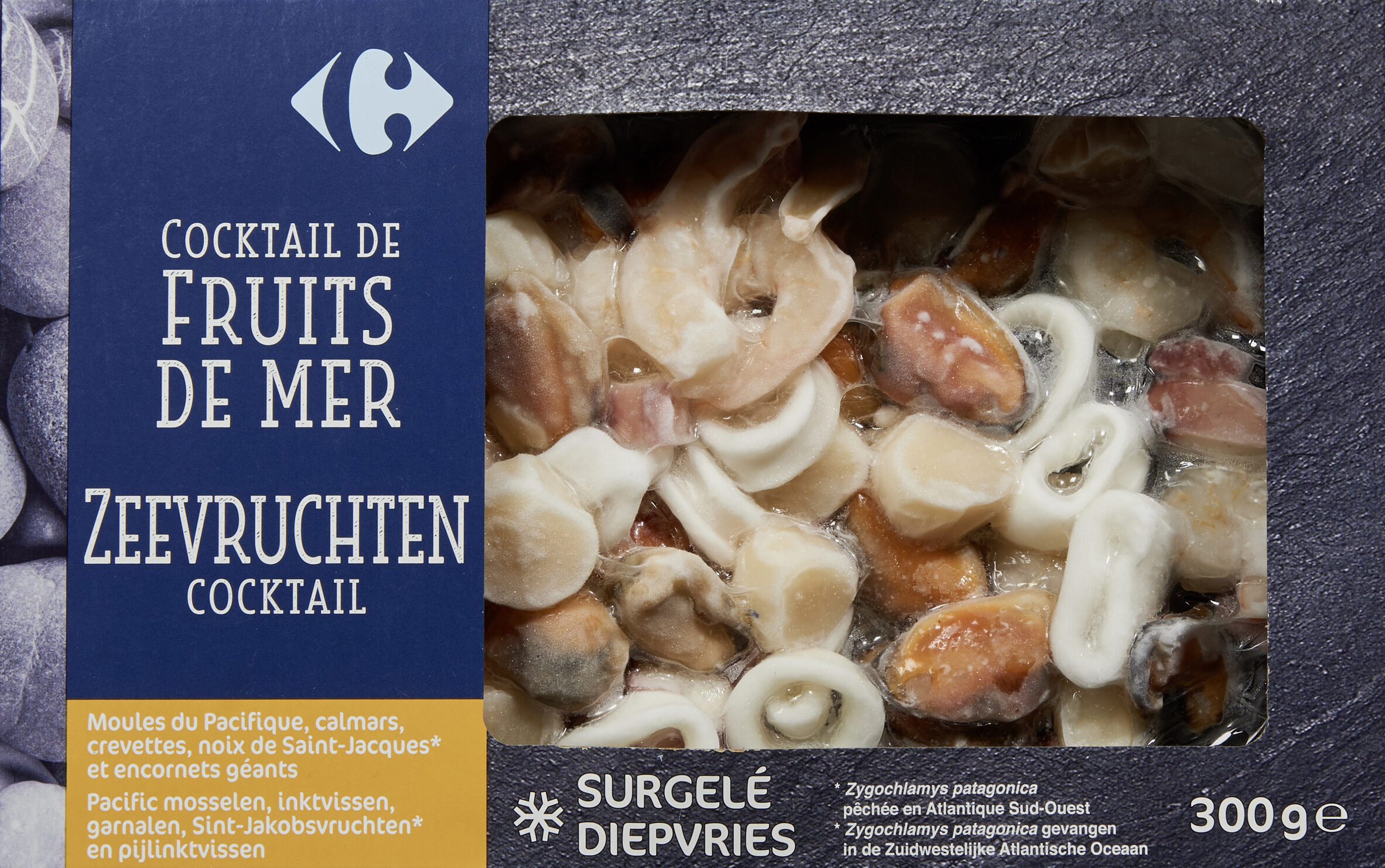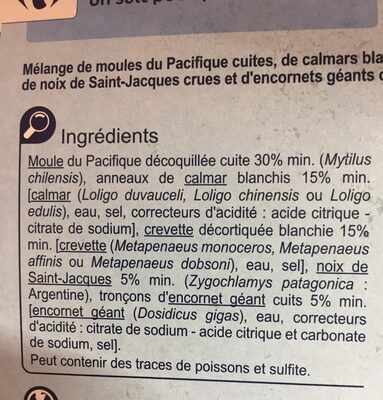Cocktail de fruits de mer - Carrefour - 300 g
Important note: this product is no longer sold. The data is kept for reference only. This product does not appear in regular searches and is not taken into account for statistics.
This product page is not complete. You can help to complete it by editing it and adding more data from the photos we have, or by taking more photos using the app for Android or iPhone/iPad. Thank you!
×
Some of the data for this product has been provided directly by the manufacturer Carrefour.
Barcode: 3560071095352 (EAN / EAN-13)
Common name: Mélange de moules du Pacifique cuites, de calmars blanchis, de crevettes blanchies, de noix de Saint-Jacques crues et d'encornets géants cuits, surgelé.
Quantity: 300 g
Packaging: fr:Etui en carton
Brands: Carrefour
Categories: Seafood, Mollusc, Mussels, fr:Moules du Pacifique
Origin of the product and/or its ingredients: Moule du Pacifique (Mytilus chilensis) élevée au Chili. Calmar (Loligo duvauceli) pêché aux chaluts en Océan Indien Ouest (A*) ; ou (Loligo chinensis ou Loligo edulis) pêché aux chaluts en Océan Pacifique Centre-Ouest et/ou Nord-Ouest (B*). Crevette (Metapenaeus monoceros, Metapenaeus affinis ou Metapenaeus dobsoni) pêchée aux chaluts en Océan Indien Ouest. Noix de St-Jacques (Zygochlamys patagonica) pêchée aux chaluts en Océan Atlantique Sud-Ouest, Origine Argentine. Encornet géant (Dosidicus gigas) pêché aux chaluts ou aux lignes et hameçons en Océan Pacifique Sud-Est. * Pour connaitre l'origine des fruits de mer, se référer au pavé de marquage.
Producer: Conditionné par EMB 14047E pour Interdis
Traceability code: FR 14.047.031 CE - Bayeux (Calvados, France), EMB 14047E - Bayeux (Calvados, France)
Stores: Carrefour
Countries where sold: France
Matching with your preferences
Environment
Carbon footprint
Packaging
Transportation
Other information
Other information: Etoile SURGELE 300g e * Zygochlamys patagonica pêchée en Atlantique Sud-Ouest Retrouvez toutes les saveurs de la mer dans le cocktail de fruits de mer Carrefour. Les moules, calmars, crevettes, noix de Saint-Jacques et encornets géants vous permettront de confectionner des tapas, des salades composées (cuisson préalable nécessaire) ou des plats chauds savoureux : risotto, pâtes, pizzas, paella... Soyez inventif et bon appétit ! Moules du Pacifique, calmars, crevettes, noix de Saint-Jacques* et encornets géants
Preparation: Sans décongélation : Cuisson vapeur : Retirez l'étui carton et disposez la barquette surgelée dans le four à micro-ondes sans ouvrir l'opercule. Réchauffez 5 minutes à 900 watts. Laissez reposer 1 minute avant de déguster pour éviter tout risque de brûlure. A la poêle : Faites revenir le cocktail pendant 5 minutes environ dans un peu de matière grasse. Remuez régulièrement. Décongélation : Retirez l'étui carton et placez la barquette surgelée sans ouvrir l'opercule dans un four à micro-ondes position « décongélation » pendant 5 minutes environ. Utilisez ensuite le cocktail comme un produit frais.
Warning: Le produit est recouvert d'une fine pellicule de glace afin de le protéger de la déshydratation du froid. Avant utilisation, nous vous conseillons de rincer le produit à l'eau froide.
Conservation conditions: A consommer de préférence avant la date indiquée sur le côté de la boîte et à conserver 24 heures au réfrigérateur, 3 jours dans le compartiment à glace du réfrigérateur, plusieurs mois à -18°C dans un congélateur *** ATTENTION, NE PAS RECONGELER APRES DECONGELATION
Customer service: Interdis - TSA 91431 - 91343 MASSY Cedex - France
Report a problem
Data sources
Product added on by kiliweb
Last edit of product page on by org-carrefour.
Product page also edited by autorotate-bot, carrefour, openfoodfacts-contributors, roboto-app, sebleouf, teolemon, yuka.Um9NY0FZSTZncVJRa05zdjhCalgwOHA4L1kySWZHZWJNTE5QSVE9PQ.








